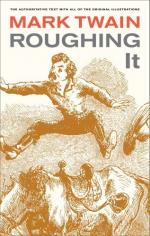I do not remember where we first came across “sage-brush,” but as I have been speaking of it I may as well describe it.
This is easily done, for if the reader can imagine a gnarled and venerable live oak-tree reduced to a little shrub two feet-high, with its rough bark, its foliage, its twisted boughs, all complete, he can picture the “sage-brush” exactly. Often, on lazy afternoons in the mountains, I have lain on the ground with my face under a sage-bush, and entertained myself with fancying that the gnats among its foliage were liliputian birds, and that the ants marching and countermarching about its base were liliputian flocks and herds, and myself some vast loafer from Brobdignag waiting to catch a little citizen and eat him.
It is an imposing monarch of the forest in exquisite miniature, is the “sage-brush.” Its foliage is a grayish green, and gives that tint to desert and mountain. It smells like our domestic sage, and “sage-tea” made from it taste like the sage-tea which all boys are so well acquainted with. The sage-brush is a singularly hardy plant, and grows right in the midst of deep sand, and among barren rocks, where nothing else in the vegetable world would try to grow, except “bunch-grass.” —["Bunch-grass” grows on the bleak mountain-sides of Nevada and neighboring territories, and offers excellent feed for stock, even in the dead of winter, wherever the snow is blown aside and exposes it; notwithstanding its unpromising home, bunch-grass is a better and more nutritious diet for cattle and horses than almost any other hay or grass that is known—so stock-men say.]—The sage-bushes grow from three to six or seven feet apart, all over the mountains and deserts of the Far West, clear to the borders of California. There is not a tree of any kind in the deserts, for hundreds of miles—there is no vegetation at all in a regular desert, except the sage-brush and its cousin the “greasewood,” which is so much like the sage-brush that the difference amounts to little. Camp-fires and hot suppers in the deserts would be impossible but for the friendly sage-brush. Its trunk is as large as a boy’s wrist (and from that up to a man’s arm), and its crooked branches are half as large as its trunk—all good, sound, hard wood, very like oak.
When a party camps, the first thing to be done is to cut sage-brush; and in a few minutes there is an opulent pile of it ready for use. A hole a foot wide, two feet deep, and two feet long, is dug, and sage-brush chopped up and burned in it till it is full to the brim with glowing coals. Then the cooking begins, and there is no smoke, and consequently no swearing. Such a fire will keep all night, with very little replenishing; and it makes a very sociable camp-fire, and one around which the most impossible reminiscences sound plausible, instructive, and profoundly entertaining.




